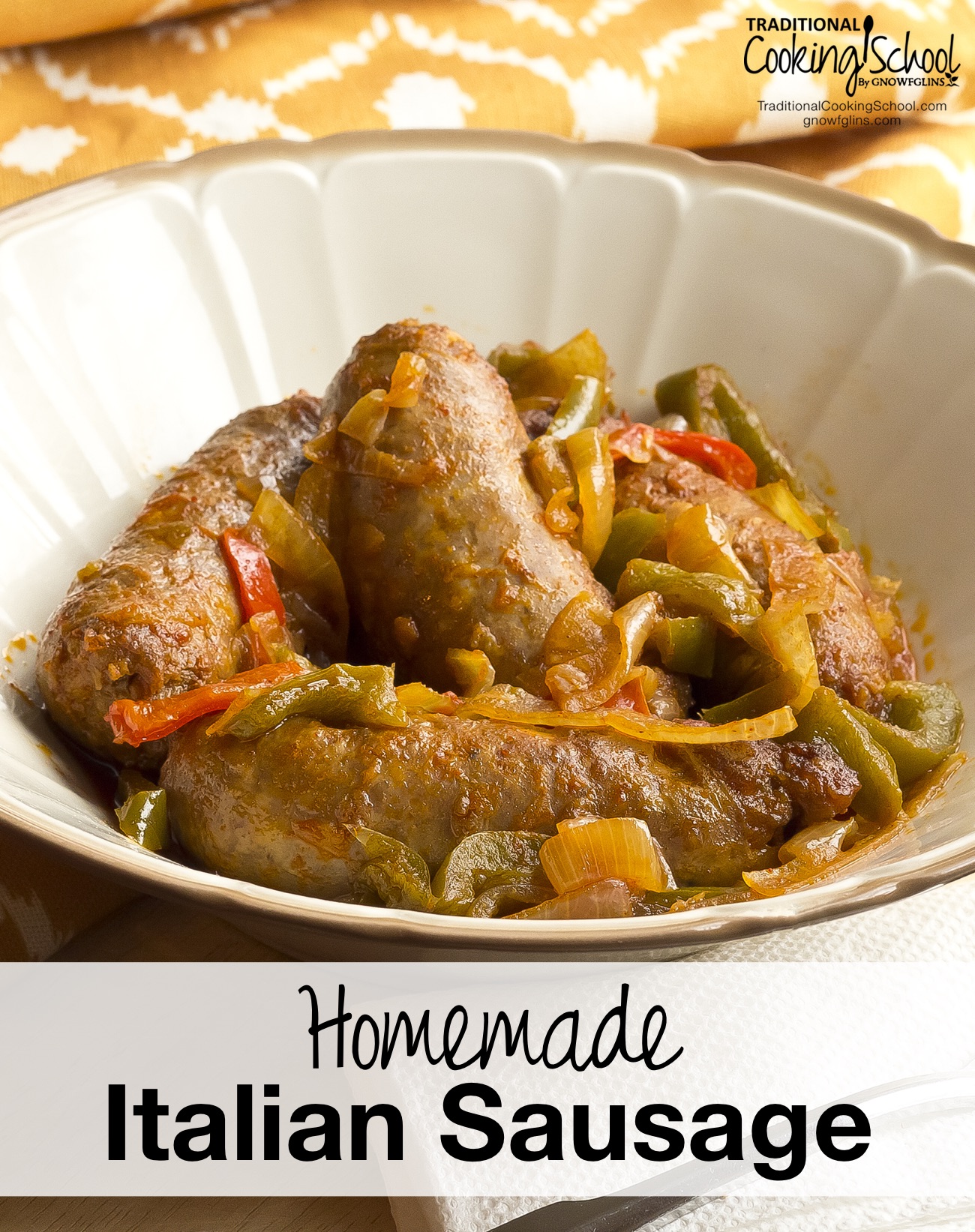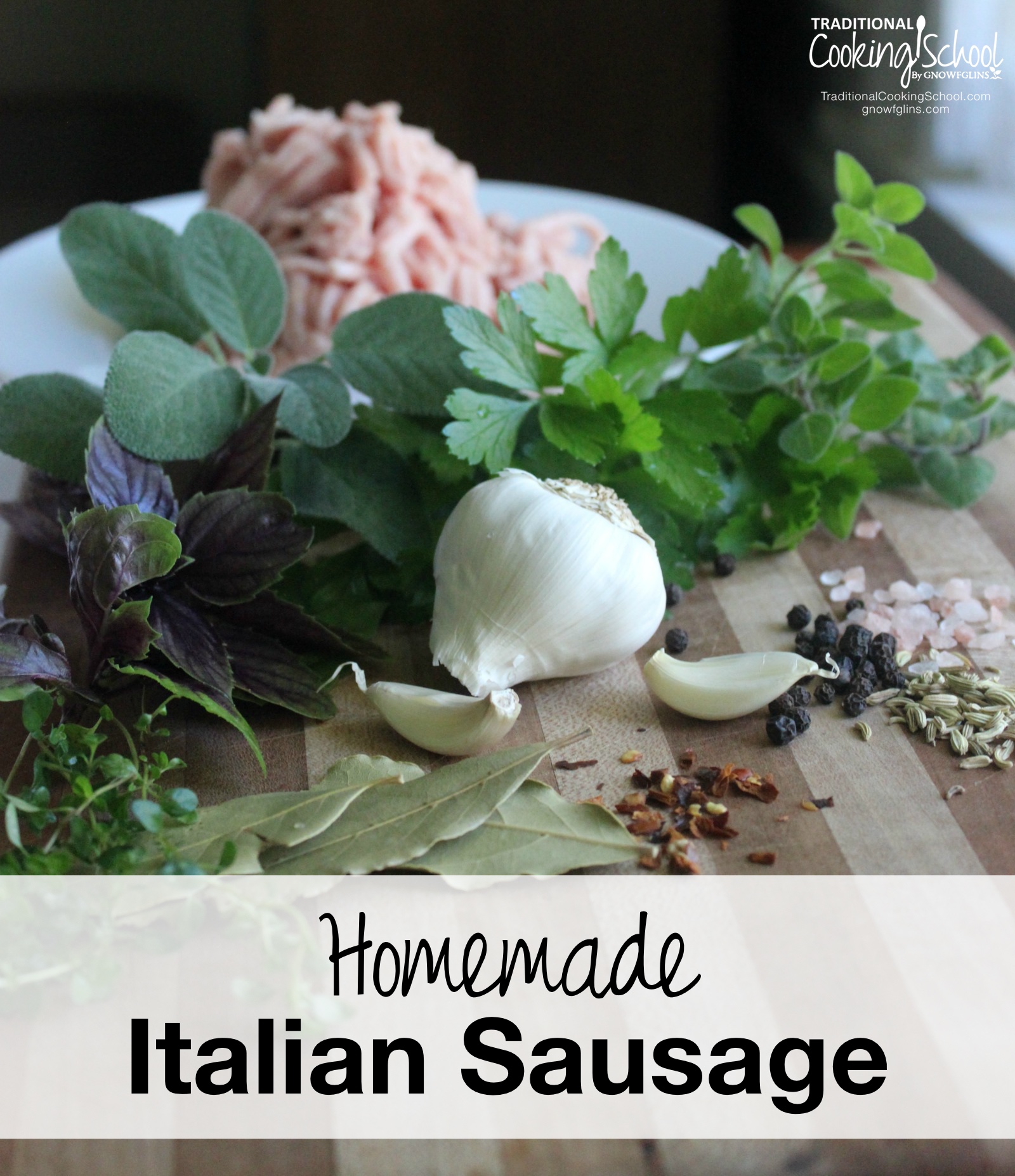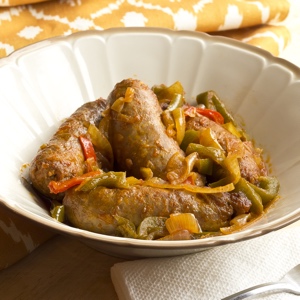
Sausage… A gourmet delicacy, yet it is the essence of nose-to-tail farm frugality.
Nothing goes to waste when all the scraps and small pieces of meat are used to make sausage.
Salting, smoking, fermenting, and drying are all ways to preserve meat for longer without refrigeration.
The History
Traditionally, sausage was made from pork, beef, or veal, but it can be made from any type of meat — including seafood.
Nearly every culture has their own sausage: Italian salami, German bratwurst, Polish kielbasa, English bangers, Irish sausage, Cajun andouille, Spanish chorizo, Brazilian Linguica de Porco, Thai Sai Krok Isan, Lebanese makanek, Chinese lop chong.
Dry cured sausages like salami and chorizo are preserved through fermentation and cultured with lactic acid to add another layer of flavor.
Cooks began adding saltpeter (potassium nitrate) — one of the first chemical preservatives — during the Middle Ages. Saltpeter kept sausages from spoiling while also retaining the fresh pink color inside. One common historical source for saltpeter was soaked, filtered bat guano.
Modern chemical preservatives like BHT, BHA, TBHQ, potassium sorbate, and sodium benzoate are still commonly added to commercial sausages to prevent rancidity, extend shelf life, and kill microbes. All of these, however, pose serious health threats.
Many commercially-produced sausages also contain highly processed flavorings which include GMO corn syrup solids, sucrose, dextrose, monosodium glutamate (MSG), and other hidden sources of MSG such as autolyzed yeast extract and hydrolyzed plant proteins.
Why Chemicals?
Why the need for chemicals, if traditional sausages were already effectively (and deliciously) preserved?
They cover up the flavor of low quality ingredients, speed up the curing process, and kill pathogens present on CAFO meat.
While saltpeter may have prevented botulism, it was never effective against salmonella or E. coli. And the fact is, newer preservatives and antimicrobials still can’t prevent the contamination of carelessly handled meat, or meat that already contains resistant microbes.
The addition of GMO sweeteners and excitotoxic glutamates will certainly fool taste buds into thinking they have a tasty artisanal product, but it’s all as real as the emperor’s new clothes.
Making Sausage The Right Way
Sausage made at home from the best local, pastured meats, mixed with tons of wholesome flavor, avoids all the chemicals found in processed meats.
With the right ratio of salt, pepper, and sugar, a mix of fresh pork, beef, or other ground meat can cure safely in your refrigerator. The addition of wine or vinegar strengthens the cure even more, while adding moisture and flavor. The finished product isn’t shelf stable unless dried or smoked, but this method does yield the delicious flavor of a high-end charcuterie. It also freezes well for longer storage.
This recipe calls for curing for 3 to 7 days in the refrigerator. To ensure a safe curing, don’t alter the amounts of salt, pepper, and sugar.
If pressed for time, the sausage can be mixed up and cooked the next day. The flavors won’t be as developed and it may be too salty, but if you know you aren’t going to cure it, just reduce the salt to 1 teaspoon per 1 pound of meat.


Homemade Italian Sausage
Adapted from Julia and Jacques Cooking at Home.
Ingredients
- 2-1/2 teaspoons sea salt required
- 3/4 teaspoon ground black pepper required
- 1/2 teaspoon evaporated cane juice required
- 2 teaspoons ground sage
- 1/2 teaspoon dried thyme
- 1/2 teaspoon ground cayenne pepper optional
- 1 bay leaf crumbled
- 1/2 teaspoon fennel seed crushed
- 1/2 teaspoon dried basil
- pinch red pepper flakes
- 1/2 teaspoon dried oregano
- 1-1/2 pounds pastured pork fresh ground
- 2 tablespoons red wine
- 2 cloves garlic pressed
Instructions
-
Prepare the spice mixture by combining the basic curing mix of salt, black pepper, and sugar with the remaining dried spices in a bowl.
-
Set aside.
-
Place the pork in a large bowl and add the spice mixture, wine, and garlic.
-
Combine thoroughly with your hands, much as you would knead yeast bread.
-
When all seasonings are incorporated, make a small test patty.
-
Cook the patty until done to make sure the meat holds together when cooked and to taste for seasonings.
-
Remember that it will be salty.
-
Shape the meat into a large log on a sheet of waxed paper.
-
Roll the paper around the log and gently squeeze it into a sausage roughly 12 to 14 inches long.
-
Tightly fold the ends and then wrap again in aluminum foil, making sure to seal tightly.
-
Place the sausage in the refrigerator to cure for 3 to 7 days.
-
Remember, the meat will not stay pink because it doesn't contain nitrates.
-
Once meat is cured, if you have a sausage stuffer, put it into casings.
-
To poach, fill a large saucepan with enough water to cover the sausage.
-
Bring the water to a near simmer and place the sausage into the pan.
-
Add beer, wine, broth, or spices if desired.
-
Keep sausage submerged for about 40 minutes with the water remaining at a gentle simmer.
Recipe Notes
Variations:
Instead of stuffing into casings, form the meat into patties to grill or fry.
Sausage can also be browned and crumbled onto pizzas or casseroles.
The World Is Your Sausage
You can develop so many delicious sausages with this recipe. Keep the basic salt, pepper, and sugar ratio for each 1-1/2 pounds of meat, and then get creative with your favorite seasonings!
Julia Child liked bay leaf, clove, mace, nutmeg, paprika, thyme, cinnamon, savory, and white pepper. Diversify your flavors with mixes like herbes de Provence, taco seasoning (scroll down page), or garam masala.
Find your favorite meat, too — such as lamb, chicken, turkey, wild game, or even shrimp.
And give my other sausage recipes a try!
The world is your sausage. 🙂
Do you make your own sausages? Would you like to try?
...without giving up the foods you love or spending all day in the kitchen!

2 free books:
Eat God's Way
Ditch the Standard American Diet, get healthier & happier, and save money on groceries...
We only recommend products and services we wholeheartedly endorse. This post may contain special links through which we earn a small commission if you make a purchase (though your price is the same).


lOVE this article…you say place meat with seasonings in refrig to cure but is leaving it in the refrig a certain amount of time is what cures it? How long? Thanks so much for your generous info. God Bless.
it is the length of time the raw meat is allowed to come in contact with the salt/sugar/pepper curing mixture that actually cures it. In olden times this was done without refrigeration, however it is much safer to do in the refrigerator. The recipe states 3-7 days. The longer you cure the more intense the flavor. Hope this helps!
Hi Wardeh! My husband and I are planning on buying a pig soon from a local farm. This is our first time doing so. We plan on getting a lot of ground pork to make our own sausage, so this was a well-timed article for us. Thank you! Would it be safe to freeze the pork when we get it and then thaw it and make it into sausage using this recipe, or do we need to make it from fresh right when we receive it? (I noticed the recipe said “fresh” so I thought I should ask.) Also, if you have any advice on what to request from the butcher so we can get the most out of the pig, we would really appreciate it. I would like to try rendering lard, using the bonesf (if recommended), etc.
Can you give drying instructions?
I recommend getting a book specifically geared toward home preservation methods in order to successfully dry sausages such as:
The Complete Book of Butchering, Smoking, Curing, and Sausage Making: How to Harvest Your Livestock & Wild Game (Complete Meat) by Philip Hasheider
I have an old Frugal Gourmet cookbook that describes the process and it sounds easy enough. Hanging the stuffed sausages so they are not touching each other and have air circulation room around them, then aiming an electric oscillating fan at them constantly for 2-3 days. They will still need refrigeration or freezing however. Please don’t try this at home unless you get specific instructions 🙂 I haven’t tried it myself!
why is sugar a required ingredient? could i substitute a different type of sugar like coconut sugar or maple syrup. we have a daughter who is very sensative to any type of white or cane sugar.
unfortunately the sugar is a required ingredient, it is part of what stabilizes the curing process. If you were going to just make this as fresh sausage and not try to cure it for the week-long curing, or drying it, then you could probably omit the sugar, just as long as you cooked it within about 24 hours of mixing it up. As far as substituting another sugar, I would just be guessing here but it seems like coconut sugar or an unrefined cane sugar such as sucanat would work. I think maple syrup would make too much of a texture change and make the mixture too wet.
I do not eat pork, can I use beef or veal? Also is ground pastured required? can I just use ground beef or veal from my local butcher?
I thought pork was not recommended by Weston Price? I’m confused but trying to find a way to keep my kiddos’ favorite breakfast on the menu as it is the only meat they will eat! I usually buy sausages at a local farm made with pastured pork, salt, spices and no nitrates. Do I need to prepare it further before eating?
Pork was a staple food for many traditional cultures. The key is preparation. Here is a link to the Weston A Price Foundation’s own studies on traditional pork preparation
https://www.westonaprice.org/health-topics/food-features/how-does-pork-prepared-in-various-ways-affect-the-blood/
This was a very informative post, thanks. I am looking to cure the sausages in my refrigerator for 4 to 5 weeks. Would this recipe work for that?